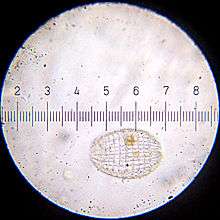Coleps
| Coleps | |
|---|---|
 | |
| Scientific classification | |
| Domain: | Eukarya |
| (unranked): | Sar |
| (unranked): | Alveolata |
| Phylum: | Ciliophora |
| Class: | Prostomatea |
| Genus: | Coleps Nitzsch |
Coleps is a genus of ciliated Prostomatea with barrel-shaped bodies.[1] They can grow up to 250 micrometers in length, but are usually under 100 micrometers in their longest axis.[1] Coleps can be taxonomically distinguished by the ornamentation of their ectoplasmic calcium carbonate plates.[1]
Predatory Manner
Coleps feeds on bacteria, algae, flagellates, living and dead ciliates, animal and plant tissues.[2] Coleps uses toxicysts, poison it carries to capture its prey from its oral area. It extrudes tube-like structures to force toxicysts into its prey and wait until its prey becomes paralyzed. These toxicysts, however, takes about 5–10 minutes to be effective on the prey of the Coleps and it separates itself from the prey during this time.[2] If there are numerous Coleps hunting for the same prey, some Colpes will cling to its prey until the toxicysts become effective and fragment the prey, consuming only few parts.[2]
References
- 1 2 3 Carey, Philip G. (1992). Marine Interstitial Ciliates : An Illustrated Key. London ; New York: Chapman Hall. pp. 44–47. ISBN 0-412-40610-1.
- 1 2 3 Buonanno, Federico; Anesi, Andrea; Guella, Graziano (January 2014). "Chemical Offense by Means of Toxicysts in the Freshwater Ciliate, Coleps hirtus". Eukaryotic Microbiology. doi:10.1111/jeu.12106.
Further reading
- Lemloh, ML; Marin, F; Herbst, F; Plasseraud, L; Schweikert, M; Baier, J; Bill, J; Brümmer, F (February 2013). "Genesis of amorphous calcium carbonate containing alveolar plates in the ciliate Coleps hirtus (Ciliophora, Prostomatea).". Journal of structural biology. 181 (2): 155–161. doi:10.1016/j.jsb.2012.12.001. PMID 23228488. Retrieved 9 February 2015.
- Wickham, Stephen A.; Gugenberger, Eva (November 2008). "Evaluating inducible morphological defences in the common freshwater ciliate, Coleps hirtus". Journal of Plankton Research. 30 (11): 1315–1321. doi:10.1093/plankt/fbn076. Retrieved 12 February 2015.
